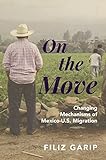On the Move : Changing Mechanisms of Mexico-U.S. Migration / Filiz Garip.
Material type: TextSeries: Princeton Analytical Sociology Series ; 2Publisher: Princeton, NJ : Princeton University Press, [2016]Copyright date: ©2017Description: 1 online resource (312 p.) : 9 halftones. 16 line illus. 5 tables. 4 mapsContent type:
TextSeries: Princeton Analytical Sociology Series ; 2Publisher: Princeton, NJ : Princeton University Press, [2016]Copyright date: ©2017Description: 1 online resource (312 p.) : 9 halftones. 16 line illus. 5 tables. 4 mapsContent type: - 9780691161068
- 9781400883769
- Immigrants -- United States
- Mexicans -- United States
- Mexico -- Emigration And Immigration
- United States -- Emigration and immigration
- SOCIAL SCIENCE / Emigration & Immigration
- Immigration Reform and Control Act
- Mexican immigrants
- Mexican migrant
- Mexican migrants
- Mexico
- MexicoЕ.S. migration
- United States
- better employment
- border enforcement
- circular migrants
- crisis migrants
- employment opportunity
- family migrants
- first-time migrants
- immigration policy
- inflation rates
- male migrants
- migrant groups
- migration behavior
- migration flow
- migration flows
- migration patterns
- migration
- urban migrants
- online - DeGruyter
- Issued also in print.
| Item type | Current library | Call number | URL | Status | Notes | Barcode | |
|---|---|---|---|---|---|---|---|
 eBook
eBook
|
Biblioteca "Angelicum" Pont. Univ. S.Tommaso d'Aquino Nuvola online | online - DeGruyter (Browse shelf(Opens below)) | Online access | Not for loan (Accesso limitato) | Accesso per gli utenti autorizzati / Access for authorized users | (dgr)9781400883769 |
Browsing Biblioteca "Angelicum" Pont. Univ. S.Tommaso d'Aquino shelves, Shelving location: Nuvola online Close shelf browser (Hides shelf browser)

|

|

|

|

|

|

|
||
| online - DeGruyter Good Form : The Ethical Experience of the Victorian Novel / | online - DeGruyter Reaping Something New : African American Transformations of Victorian Literature / | online - DeGruyter Kierkegaard's Journals and Notebooks, Volume 9 : Journals NB26-NB30 / | online - DeGruyter On the Move : Changing Mechanisms of Mexico-U.S. Migration / | online - DeGruyter Getting Respect : Responding to Stigma and Discrimination in the United States, Brazil, and Israel / | online - DeGruyter Torture and the Twilight of Empire : From Algiers to Baghdad / | online - DeGruyter Hymns and Fragments / |
Frontmatter -- Contents -- List of Illustrations -- List of Tables -- Acknowledgments -- Introduction -- 1. Why Do People Migrate? -- 2. "Go Work Over There and Come Do Something Here" -- 3. "We Leave to Help Our Parents Economically" -- 4. "Your Place Is Where Your Family Is" -- 5. "Putting Down Roots" -- 6. Where Do We Go from Here? -- Appendixes -- Notes -- References -- Index
restricted access online access with authorization star
http://purl.org/coar/access_right/c_16ec
Why do Mexicans migrate to the United States? Is there a typical Mexican migrant? Beginning in the 1970s, survey data indicated that the average migrant was a young, unmarried man who was poor, undereducated, and in search of better employment opportunities. This is the general view that most Americans still hold of immigrants from Mexico. On the Move argues that not only does this view of Mexican migrants reinforce the stereotype of their undesirability, but it also fails to capture the true diversity of migrants from Mexico and their evolving migration patterns over time.Using survey data from over 145,000 Mexicans and in-depth interviews with nearly 140 Mexicans, Filiz Garip reveals a more accurate picture of Mexico-U.S migration. In the last fifty years there have been four primary waves: a male-dominated migration from rural areas in the 1960s and '70s, a second migration of young men from socioeconomically more well-off families during the 1980s, a migration of women joining spouses already in the United States in the late 1980s and '90s, and a generation of more educated, urban migrants in the late 1990s and early 2000s. For each of these four stages, Garip examines the changing variety of reasons for why people migrate and migrants' perceptions of their opportunities in Mexico and the United States.Looking at Mexico-U.S. migration during the last half century, On the Move uncovers the vast mechanisms underlying the flow of people moving between nations.
Issued also in print.
Mode of access: Internet via World Wide Web.
In English.
Description based on online resource; title from PDF title page (publisher's Web site, viewed 30. Aug 2021)


